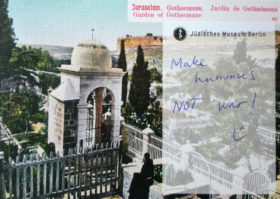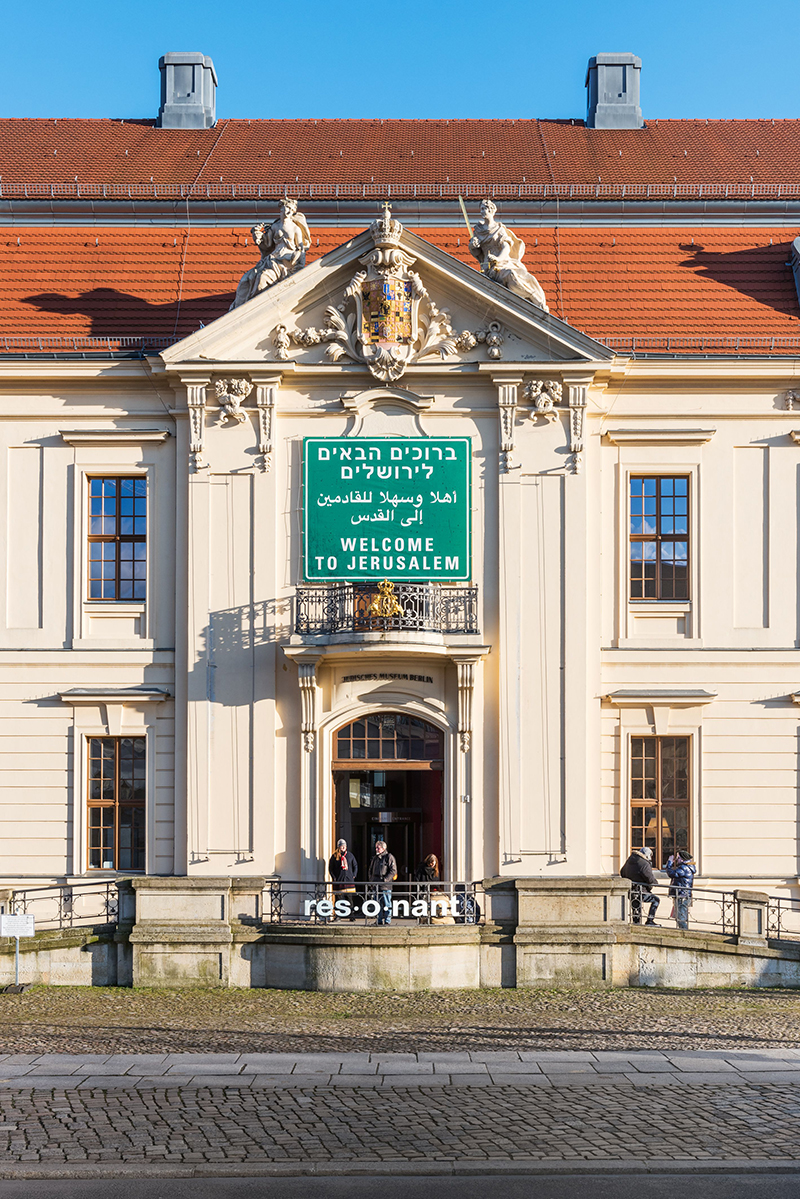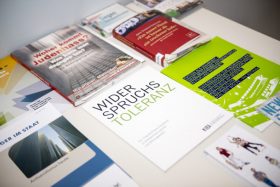Comments from Visitors to our Jerusalem Exhibition

Visitors can leave a comment, greeting, or anything else that fits on a post card on a wall titled “Next year in Jerusalem” at the end of the exhibition; Jewish Museum Berlin.
I’m standing in the hallway at the end of the current exhibition Welcome to Jerusalem (learn more at our website), talking to visitors at random if they seem open to a brief conversation about the exhibition.
Was today your first visit to Jerusalem?
Elke (around 50 years old) from Berlin was in Jerusalem in 2000, and some of the things in the exhibition resonated for her. Norbert (69) from Bremen had never been there, but the exhibition made him want to see “this tremendous mish-mash of religions and peoples.”
To Marianna and Marta from Italy, who were just “in the city” for the first time, Jerusalem seemed above all else old, international, and rich in history. Lorenza (54) also from Italy, thought the video installations in the exhibition were particularly interesting because they show modern Jerusalem, which is nonetheless full of tradition. None of the three would wager a real trip to Jerusalem right now because of the political situation.
The Israelis Malka (58) and Shani (27) live near Tel Aviv but are very familiar with Jerusalem. Jonny (27) and Nora (24) even got married there.
Does the exhibition reflect the image of Jerusalem as you know it?
→ continue reading
On the difficulties the organizers of the “Welcome to Jerusalem” exhibition encountered doing justice to the ideal of justice

The much-discussed sign outside the museum, Jewish Museum Berlin, photo: Jule Roehr
In the Islamic tradition and in the Koran itself, the biblical story of David and Uriah is told in a metaphorical form that differs from the version in the Bible (Koran: Sura 38/21–25): two brothers come to King David and ask him to settle a dispute between them. One of them describes the situation. He tells David that his brother has 99 ewes, but he himself only has one. Now his brother was pressuring him to give him his only ewe. Directly after this brief depiction, David passes his judgment: the one brother’s desire to add the one ewe to his 99 was an injustice to the other brother. The judgment could have been the end of the story, had David not suddenly realized that his decision was unjust. He regretted it deeply. Many Muslim commentators have discussed the sudden turn in the story. One explanation for why the judgment is unjust despite the clarity of the situation is that David made his decision after hearing only one side. In this interpretation, the moral of the story is that in conflicts or disputes, both sides must be allowed to present their perspectives and arguments. → continue reading
Experts discuss political adult education on the Middle East conflict

Many educational providers offer materials for confronting anti-Semitism pedagogically; Jewish Museum Berlin, photo: Nadja Rentzsch
“Emotional” and “complex” are words often used to describe the Middle East conflict and approaches to it. How should it be handled in the everyday practice of education and continuing education? This is one of the questions in my research project “Didactics of the Middle East Conflict,” which I am conducting as a W. M. Blumenthal Fellow (more about the project on the museum website).
At a university or an institute, generally there is a research colloquium full of people working on similar themes, or who at least come from the same discipline. In such colloquia, one can present new work, discuss initial findings, get feedback about dealing with difficulties, and discover stimulating new ideas. At a museum, people engage with a great variety of topics, but not with empirical research on the didactics of the Middle East conflict. And so on September 8th, I invited external experts on educational work relating to the Middle East conflict, anti-Semitism, and racism to come to the museum. We discussed teaching and learning on this subject with members of the Education Department and the museum’s Academy Programs. → continue reading


